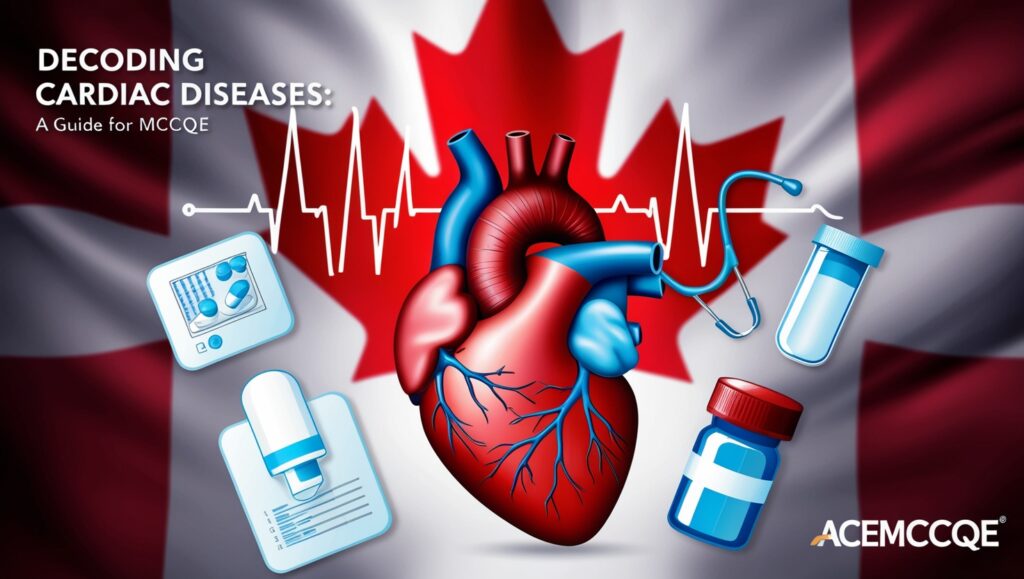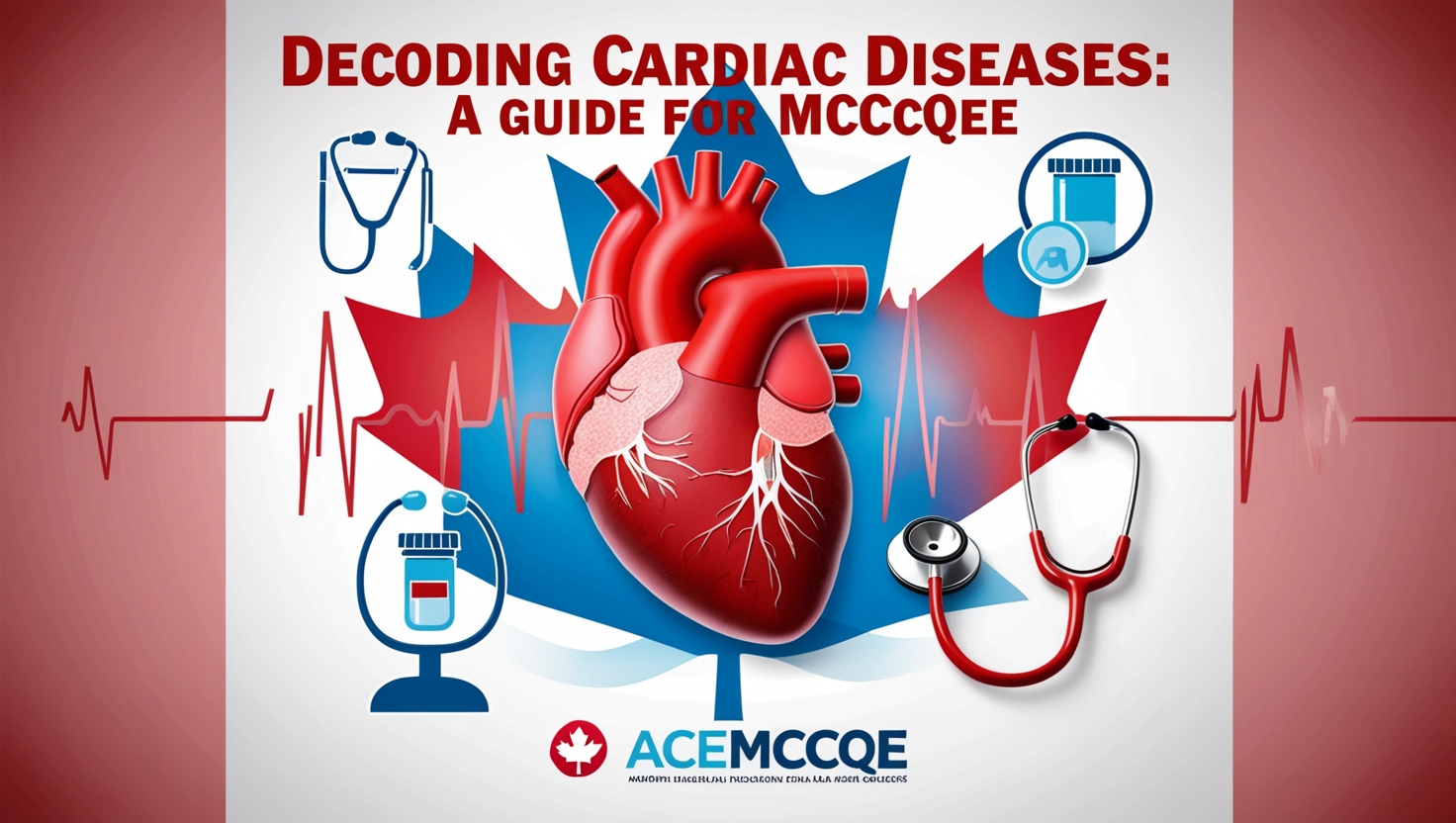Cardiovascular diseases (CVDs) are among the leading causes of mortality worldwide, making them a crucial area of focus in medical education and practice. For candidates preparing for the Medical Council of Canada Qualifying Examination (MCCQE) Part 1, a thorough understanding of cardiac diseases is essential. This guide will help break down key cardiac conditions, their pathophysiology, clinical presentation, diagnostic approaches, and management strategies, providing candidates with a structured approach to mastering this topic for the exam.
Understanding Cardiac Diseases

Cardiac diseases encompass a broad spectrum of conditions that affect the heart’s structure and function. These include congenital heart defects, ischemic heart disease, valvular disorders, cardiomyopathies, arrhythmias, and heart failure. Each category requires an understanding of underlying mechanisms, risk factors, clinical features, and treatment protocols.
1. Ischemic Heart Disease (IHD)
Ischemic heart disease, also known as coronary artery disease (CAD), is caused by atherosclerosis leading to reduced blood supply to the myocardium. The key conditions under IHD include:
- Stable Angina: Characterized by chest pain on exertion due to myocardial oxygen demand exceeding supply. It is relieved by rest or nitroglycerin.
- Unstable Angina: A more severe form where chest pain occurs at rest and signifies an impending myocardial infarction.
- Myocardial Infarction (MI): Occurs due to complete occlusion of a coronary artery, leading to ischemic necrosis of myocardial tissue. It is classified into ST-elevation MI (STEMI) and non-ST-elevation MI (NSTEMI) based on ECG findings.
Diagnosis & Management:
Diagnosis is based on clinical presentation, ECG, cardiac biomarkers (troponins), and imaging modalities like coronary angiography. Management includes antiplatelet therapy (aspirin, clopidogrel), beta-blockers, statins, and reperfusion therapy (PCI or thrombolysis in STEMI).
2. Heart Failure
Heart failure (HF) is a clinical syndrome where the heart fails to pump blood efficiently, leading to inadequate perfusion of tissues. It is classified into:
- Heart Failure with Reduced Ejection Fraction (HFrEF): EF <40%, often due to ischemic heart disease or dilated cardiomyopathy.
- Heart Failure with Preserved Ejection Fraction (HFpEF): EF >50%, commonly associated with hypertension and diastolic dysfunction.
Diagnosis & Management:
Clinical features include dyspnea, orthopnea, peripheral edema, and fatigue. Diagnosis is made via echocardiography, BNP levels, and chest X-ray. Management involves diuretics, ACE inhibitors, beta-blockers, aldosterone antagonists, and lifestyle modifications.
3. Valvular Heart Diseases
Valvular heart diseases affect the function of the heart valves, leading to stenosis or regurgitation. Common conditions include:
- Aortic Stenosis (AS): Age-related calcification or congenital bicuspid valve disease leads to left ventricular outflow obstruction.
- Mitral Regurgitation (MR): Commonly due to mitral valve prolapse or secondary to left ventricular dilation.
- Aortic Regurgitation (AR): Caused by rheumatic heart disease, aortic root dilation, or infective endocarditis.
- Mitral Stenosis (MS): Usually secondary to rheumatic fever, causing obstruction to left atrial emptying.
Diagnosis & Management:
Echocardiography is the gold standard for diagnosis. Management depends on severity and symptoms, ranging from medical therapy (diuretics, beta-blockers) to surgical interventions like valve replacement or repair.
4. Cardiac Arrhythmias
Arrhythmias refer to abnormal heart rhythms due to defects in the electrical conduction system. The key types include:
- Atrial Fibrillation (AF): The most common arrhythmia, characterized by irregular atrial activity and increased stroke risk.
- Ventricular Tachycardia (VT): A life-threatening condition often seen in structural heart disease.
- Bradyarrhythmias: Includes conditions like sinus node dysfunction and atrioventricular block, leading to slow heart rates.
Diagnosis & Management:
ECG is essential for diagnosis. Management varies based on the type and severity, including rate control (beta-blockers, calcium channel blockers), anticoagulation for AF, and device therapy (pacemakers, ICDs) for severe bradyarrhythmias or VT.
5. Cardiomyopathies
Cardiomyopathies are disorders of the heart muscle, leading to functional impairment. The main types include:
- Dilated Cardiomyopathy (DCM): Characterized by ventricular dilation and systolic dysfunction, often due to genetic, infectious, or toxic causes (e.g., alcohol, chemotherapy).
- Hypertrophic Cardiomyopathy (HCM): A genetic disorder causing left ventricular hypertrophy, leading to outflow obstruction and sudden cardiac death in young athletes.
- Restrictive Cardiomyopathy (RCM): Caused by infiltrative diseases (e.g., amyloidosis) leading to impaired diastolic filling.
Diagnosis & Management:
Echocardiography and cardiac MRI are key diagnostic tools. Treatment includes medications like beta-blockers, anticoagulation for thromboembolism prevention, and advanced therapies such as heart transplantation in severe cases.
6. Congenital Heart Diseases
Congenital heart diseases (CHDs) are structural abnormalities present at birth. Some common types include:
- Atrial Septal Defect (ASD): A communication between the atria, leading to left-to-right shunting.
- Ventricular Septal Defect (VSD): A hole in the ventricular septum, causing left-to-right shunting and volume overload.
- Tetralogy of Fallot (TOF): A cyanotic CHD with four defects: VSD, pulmonary stenosis, right ventricular hypertrophy, and an overriding aorta.
Diagnosis & Management:
Echocardiography and cardiac catheterization are key diagnostic modalities. Many CHDs require surgical correction or catheter-based interventions.
Exam Preparation Tips for MCCQE
- Understand Clinical Presentations: Recognizing symptoms and correlating them with different cardiac diseases is crucial for answering MCCQE questions effectively.
- Master ECG Interpretation: Many questions involve ECG analysis. Knowing normal and pathological patterns is essential.
- Know the Pharmacology: Understanding cardiac drugs, including their indications, mechanisms, and side effects, is vital.
- Practice Case-Based Questions: MCCQE focuses on clinical scenarios; practicing with case-based MCQs will enhance problem-solving skills.
- Stay Updated: Guidelines for cardiac diseases evolve. Reviewing the latest Canadian Cardiovascular Society (CCS) guidelines can be beneficial.
Conclusion
Decoding cardiac diseases is a fundamental component of MCCQE preparation. A strong grasp of pathophysiology, clinical features, diagnosis, and management strategies will not only help candidates excel in the exam but also lay a solid foundation for future clinical practice. By focusing on key areas and integrating knowledge with clinical scenarios, MCCQE candidates can approach cardiac-related questions with confidence and precision. Read more blog…



13 thoughts on “Decoding Cardiac Diseases: A Guide for MCCQE”
Comments are closed.